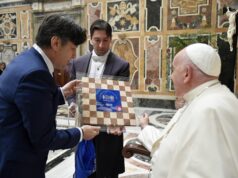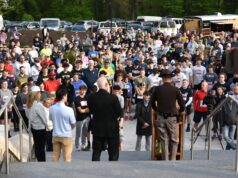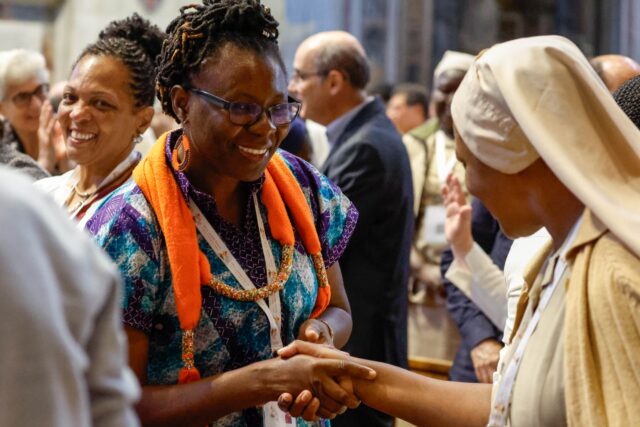
By Kimberley Heatherington
OSV News
As the Synod on Synodality opens Oct. 4 in Rome, among the most closely watched topics under discussion is the question of whether the Catholic Church can or will extend the permanent diaconate — restored after the Second Vatican Council — to women.
The synod’s working document released June 20 notes that most continental assemblies called for a discussion on the inclusion of women in the diaconate, and asked, “Is it possible to envisage this, and in what way?”
Up to now, the answer to that question is not clear and is debated.
“The key is not whether there were women deacons,” said Deacon Dominic Cerrato, director of the Office of the Diaconate in the Diocese of Joliet, Illinois, and editor of The Deacon magazine, published by OSV, which is also the parent company of OSV News.
“Of course there were women deacons. But tradition never called them part of the diaconate, never saw them as part of the diaconate,” he said.
Deacon Cerrato served with nine other international scholars on the papal commission on women and the diaconate established by Pope Francis in 2020. The pope formed an earlier commission in 2016; before that, two others were held by the International Theological Commission, which advised the Vatican’s Congregation (now Dicastery) for the Doctrine of the Faith.
The matter of women deacons or deaconesses, Deacon Cerrato maintained, has been “studied to death.”
In his understanding, the female diaconate role developed due to the ancient tradition of nude baptism — “it would not be appropriate for the bishop to see a woman in the nude,” he said — and to avoid potential scandal during individual catechetical instruction.
Deaconesses, said Deacon Cerrato, also examined signs of harm in spousal abuse cases.
“They emerged likely out of the order of widows and virgins,” he said, “and they probably morphed into abbesses and women religious.”
While Deacon Cerrato emphasized there is “no question of the historic place of deaconesses in the early church,” he cautioned — citing differences in ordination rites and discrepancies in liturgical, sacramental and ministerial roles — that this evidence is not enough to say their roles were equivalent to the male diaconate.
Deacon Cerrato said the onus is on proponents of ordaining women to the order of deacon “to demonstrate through divine revelation — and all the criteria that is set up in the standard development of doctrine — whether this is a true development of doctrine.”
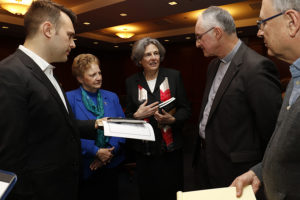
However, Phyllis Zagano, adjunct professor of religion at Hofstra University on Long Island, and co-author of the 2012 book “Women Deacons: Past, Present, Future,” told OSV News that “if the church needs deacons, it stands to reason that it needs women deacons.”
Zagano served on the papal commission on women and the diaconate established in 2016, and previously remarked that the issue can be “partly resolved by the synod, then formally approved by the pope.”
“History notes that women were sacramentally ordained as deacons in various eras and various places,” Zagano told OSV News. “The liturgies used were examined in the 17th century by Jean Morin and found to meet the criteria for sacramental ordination according to the Council of Trent.”
Father Morin, a French priest, theologian and biblical scholar, studied manuscripts of various ordination rites recorded in Greek, Latin and Syriac.
As to the objection that opening the diaconate to women could be viewed as an encouragement to the priesthood, Zagano said, “Theologically, it is important to recognize that the diaconate is not part of the priesthood, and that diaconal ordination does not necessarily qualify anyone for priestly ordination.”
Zagano noted Pope Benedict XVI “codified the distinction — already noted in the Catechism of the Catholic Church” with his 2009 apostolic letter “Omnium in Mentem.”
Pope Benedict’s text stated that those “in the order of the episcopate or the presbyterate receive the mission and capacity to act in the person of Christ the Head, whereas deacons are empowered to serve the People of God in the ministries of the liturgy, the word and charity.”
The catechism states deacons “receive the imposition of hands ‘not unto the priesthood, but unto the ministry'” and adds they are configured to Christ, “who made himself the ‘deacon’ or servant of all.”
That distinction is key — and may be the gimbal on which the anticipated synod discussion turns.
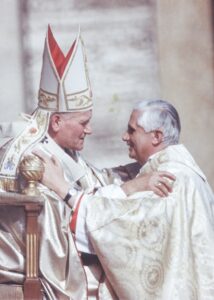
Pope St. John Paul II declared in his 1994 apostolic letter “Ordinatio sacerdotalis” that “the Church has no authority whatsoever to confer priestly ordination on women and … this judgment is to be definitively held by all the Church’s faithful.”
In his responses to a set of questions from retired cardinals made public Oct. 2, Pope Francis noted St. John Paul’s teaching on the impossibility of ordaining women to the priesthood, which “must be adhered to by all,” also has “not yet been fully developed” and can be further studied. He noted the importance of the church understanding the dynamic between the common priesthood of the faithful and the ministerial priesthood, noting the function of the latter is not about domination but “is totally ordered to the holiness of the members of Christ.”
“If this is not understood, and practical consequences are not drawn from these distinctions, it will be difficult to accept that the priesthood is reserved only for men,” Pope Francis said, “and we will not be able to recognize the rights of women or the need for them to participate in various ways in the leadership of the Church.”
Zagano has argued that Pope Francis’ 2021 modification of canon law allowing the “institution” of women, not just men, to the lay ministries of lector and acolyte could serve as a model for changing the church’s law to permit women to join the permanent diaconate.
Sister Sara Butler of the Missionary Servants of the Most Blessed Trinity, a well-known theologian who taught at two seminaries, served on St. John Paul’s International Theological Commission and wrote the 2007 book “The Catholic Priesthood and Women: A Guide to the Teaching of the Church,” told OSV News the question before Pope Francis is “whether he has the authority to admit women to the sacrament of Holy Orders as permanent deacons.”
“It’s not a question of whether he should do this, but of whether he can,” she explained.
She noted the pope has not released the reports of the two commissions he appointed to study the question.
Sister Sara said she expected the Synod’s two-year process at most to “raise the question in a way that prepares for a magisterial decision one way or the other.”
The historical case is not certain that the women who served as deaconesses in the early church would be considered as part of the diaconate that is today considered one of the “major orders” of Holy Orders, she said.
“Were they ‘women deacons’ or ‘deaconesses’?” she said.
Sister Sara’s own research has concluded “they belonged to a women’s order that the church provided in certain places to provide ministry to other women.”
In essence, Pope Francis could potentially restore the office of the “deaconess” without having to resolve the question of whether women can be ordained to the diaconate.
“There is no historical or theological obstacle to reinstating the order of deaconesses,” Sister Sara said. “They would not receive Holy Orders, but would be ‘instituted’ by the bishop in a stable, public ministerial role.”
Deacon Bill Ditewig, former executive director of the Secretariat for the Diaconate at the U.S. Conference of Catholic Bishops who has held multiple academic and diocesan posts and co-authored the 2012 book on women deacons with Zagano, noted the theological and historical debate.
The deacon told OSV News he sees the ultimate question coming down to: “Are the needs of the people of God served better if there are women and men serving as deacons?”
“Is there anything from the (church’s) history that says we shouldn’t do this, or that we can’t do this?” he said. “We were able to do it before; there’s no reason why we can’t look at it again.”
The possible sight of women deacons preaching or assisting at Mass, Deacon Ditewig admitted, may bring about a mixed reaction. “Some of those images frighten some of our fellow Catholics,” he said, “and others say, ‘No, that’s exactly what we need … that kind of witness.'”
However, when it comes to the synod discerning this crucial question, both Deacons Ditewig and Cerrato are concerned that the ones who can speak to this vocation — the church’s 49,000 permanent deacons — are almost completely absent with one exception: a Belgian deacon there to represent Europe.
“To me, that’s a pretty glaring omission,” Deacon Ditewig said. “There’s going to be questions about how to make use of the diaconate in the future — and there’s nobody there to really talk about it from any sense of experience.”
Kimberley Heatherington writes for OSV News from Virginia. Peter Jesserer Smith, OSV News national news and features editor, contributed to this report.




